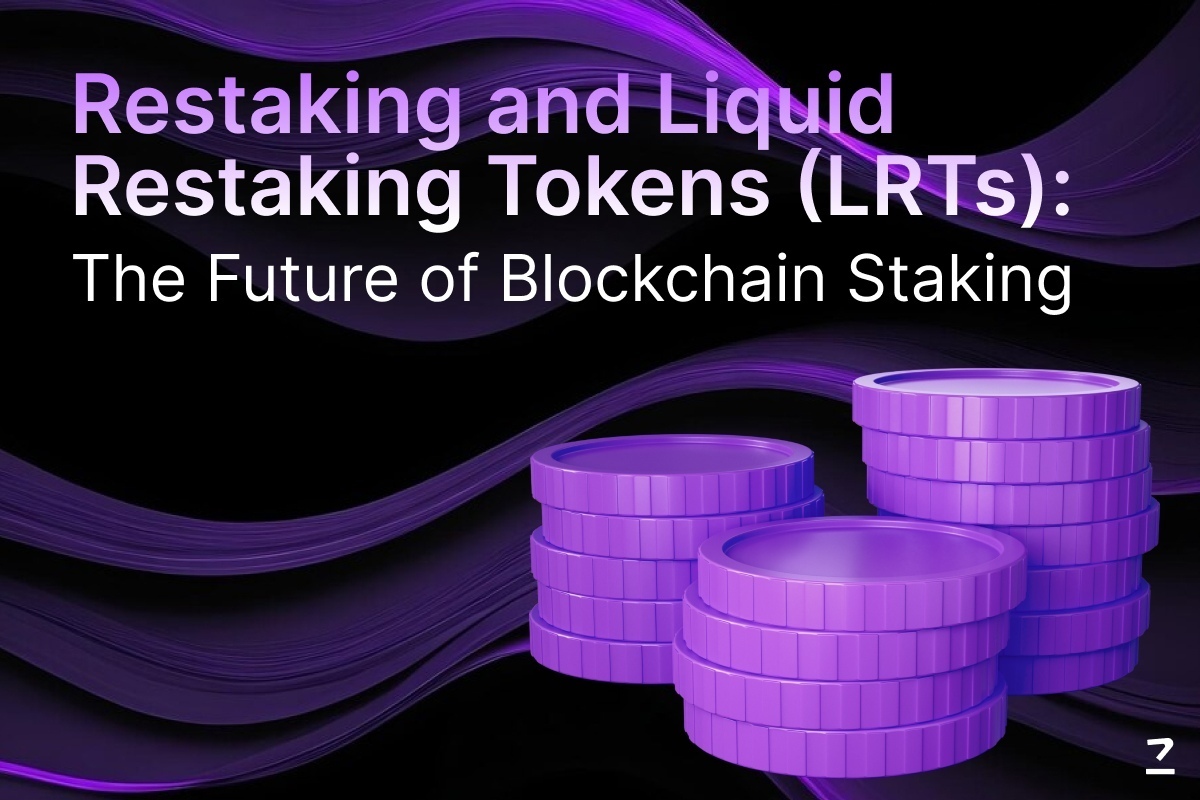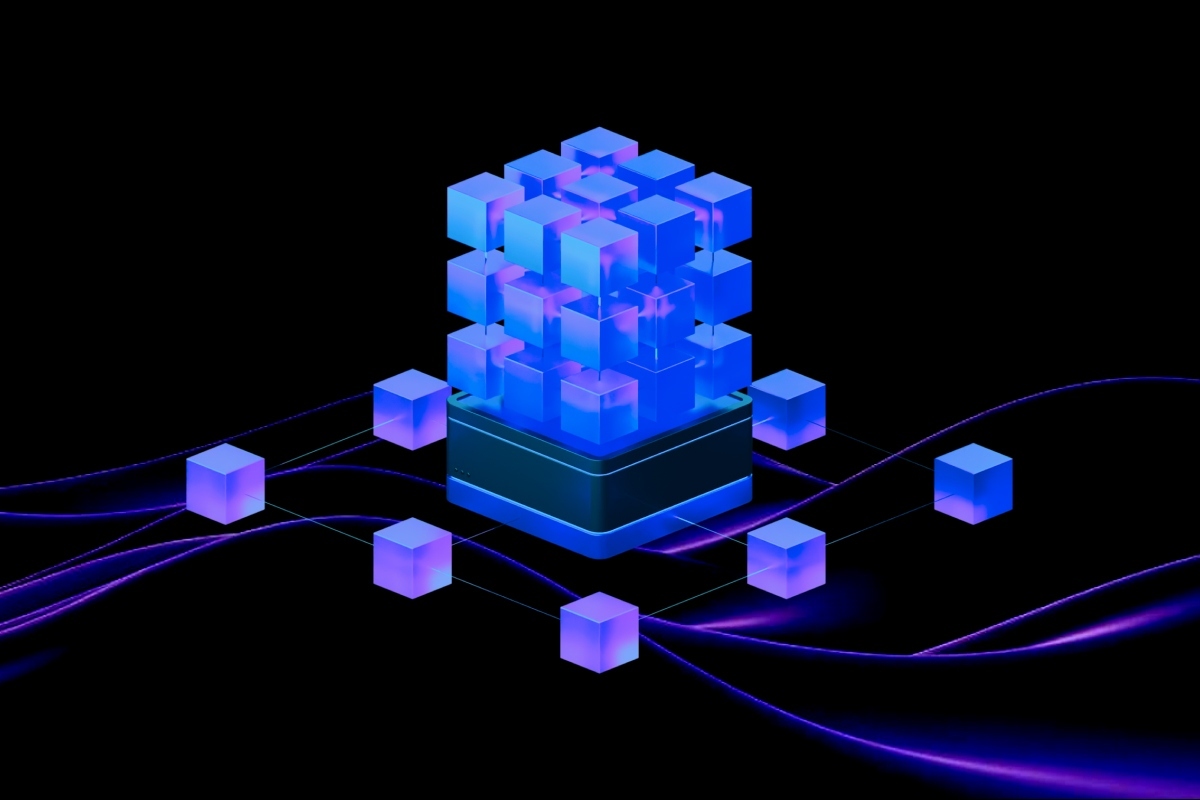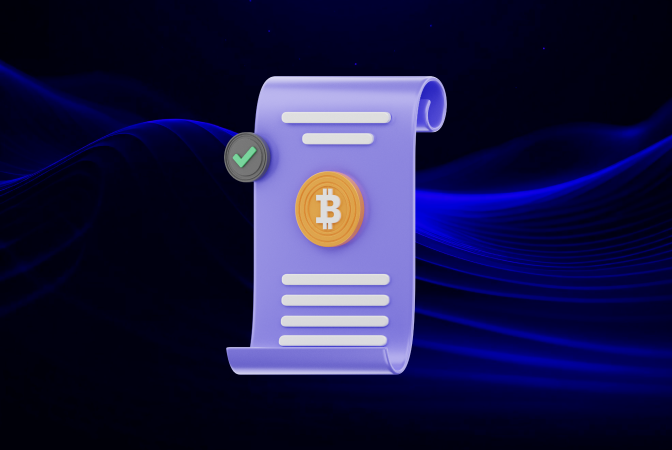SHARE THIS ARTICLE
Proof-of-Space: Chia’s Solution for Eco-Friendly Crypto Farming

The rise of cryptocurrencies has ignited a financial revolution, but its booming popularity comes with a hidden cost, which is an immense environmental footprint. Traditional Proof-of-Work (PoW) mining, the backbone of many cryptocurrencies (like Bitcoin and Ethereum 1.0), consumes staggering amounts of energy, leaving behind a trail of carbon emissions. This unsustainable reality has sparked urgent calls for solutions, and one promising answer lies in the innovative consensus mechanism of Proof-of-Space (PoS) utilized by the Chia Network.
The Chia Network is a revolutionary blockchain project pioneering a greener approach to cryptocurrency development services. Unlike PoW, which relies on powerful computers competing in a relentless energy-intensive race, Chia leverages an ingenious consensus mechanism called Proof-of-Space. The system utilizes unused storage space instead of computational power, dramatically reducing the environmental impact of securing the network.
With PoS, miners (or farmers in this case) can utilize the idle space in the hard drive of their computers and contribute to the network’s security, earning rewards in the process. This shift from energy-guzzling computations to readily available storage opens doors to a more sustainable and inclusive crypto future.
However, the benefits of PoS extend beyond environmentalism. Chia's unique approach democratizes participation, making it accessible to anyone with a hard drive, regardless of expensive mining equipment. This allows a broader community of users to participate and leads to a more decentralized network.
So, suppose you're concerned about the environmental impact of cryptocurrencies while seeking a secure and accessible way to participate. In that case, PoS and Chia Network might just offer the answer you've been searching for. Let’s explore this technology in detail, along with its potential to reinvent the future of crypto.
How Does the Proof-of-Space Consensus Work?
At its core, Proof-of-Space (PoS) flips the script on traditional crypto mining. Instead of relying on vast amounts of computational power, PoS leverages readily available storage space.
PoW mining resembles a marathon - powerful computers compete, burning immense energy, to reach the finish line first and secure the network. PoS, on the other hand, is more like a lottery - participants, or "farmers," dedicate a portion of their storage space (their "tickets") to the network. The more space you contribute, the higher your chance of "winning" the lottery and earning rewards.
Here's a breakdown of the key steps in PoS:
Plotting:
Plotting involves creating special files called "plots" on your storage device. These plots hold unique cryptographic information (or hash keys), and the more plots you create, the higher your chances of securing the network and earning rewards. However, creating these plots requires some initial processing power, so it's important to find a balance between storage capacity and energy efficiency for sustainable farming.
Farming:
Once your plots are created, your computer constantly checks them, similar to how lottery tickets are validated. This translates to utilizing your storage space to participate in the network, as your device continuously monitors the network for challenges.
Challenges and Winning Blocks:
The network frequently issues "challenges," which are complex puzzles. The first farmer who uses their storage space to solve a challenge wins the right to create the next block on the blockchain and earn rewards in XCH, the native token of the Chia Network. This block verification process consumes minimal energy compared to PoW, making PoS significantly more sustainable.
However, while PoS eliminates the need for constant, energy-intensive computations, it does introduce an element of Proof-of-Time (PoT). PoT ensures that block times remain consistent and prevents malicious actors from gaming the system by creating plots too quickly. This is achieved through a mathematical function that introduces a time component to the challenge generation process. Essentially, PoT acts as a safeguard to maintain the network's integrity while minimizing energy consumption.
In essence, Chia Network's innovative approach combines the eco-friendliness of PoS with the time-based security of PoT, creating a sustainable and secure ecosystem for cryptocurrency transactions.
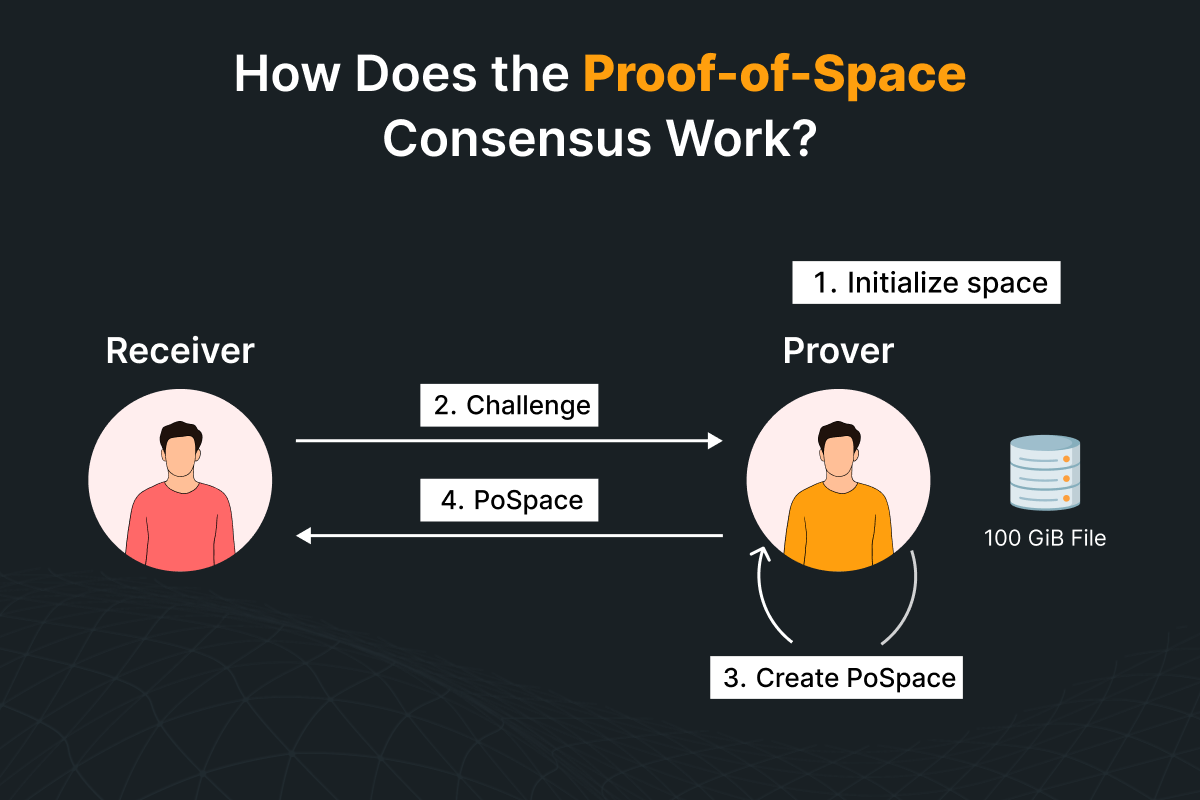
Comparing PoS to PoW
To get a broader understanding of the Proof-of-Space consensus, it’s essential to compare it to the more established Proof-of-Work (PoW) consensus mechanism used by Bitcoin and other cryptocurrencies.
Energy Consumption
One of the most significant differences lies in energy consumption. PoW, used by major cryptocurrencies like Bitcoin, relies on powerful computers competing in a relentless computational race to solve complex mathematical puzzles. This process requires vast amounts of energy, raising concerns about its environmental sustainability.
Research suggests:
-
A 2021 study by the University of Cambridge estimates Bitcoin’s annual energy consumption to be equivalent to the entire electricity use of Argentina.
-
In contrast, PoS utilizes readily available storage space, significantly reducing the energy footprint. Chia Network estimates its PoS system consumes less than 1% of the energy required by PoW, making it a much more eco-friendly alternative.
Security
While PoW boasts a long and proven security track record, PoS mechanisms are constantly evolving and improving. Studies suggest that PoS can achieve comparable security levels to PoW, especially with careful design and implementation.
However, it’s important to acknowledge that PoS systems might be susceptible to different types of attacks compared to PoW. Ongoing research and development are crucial to address potential security vulnerabilities and ensure the long-term viability of PoS.
Decentralization
Both PoS and PoW aim to achieve decentralization, meaning no single entity controls the network. PoW relies on the participation of numerous miners, while PoS distribution of power within the network. Careful consideration of token distribution models and governance mechanisms is crucial to ensure a fair and balanced system in either PoS or PoW.
While both approaches promote decentralization, the specific implementation can influence the distribution of power within the network. Careful consideration of token distribution models and governance mechanisms is crucial to ensure a fair and balanced system in either PoS or PoW.
Scalability
Scalability refers to a network’s ability to handle increasing transaction volume. PoW systems face challenges with scalability as the number of transactions grows, potentially leading to slower transaction processing times and higher fees.
PoS, in theory, offers better scalability as it doesn’t rely on complex computations for each transaction.
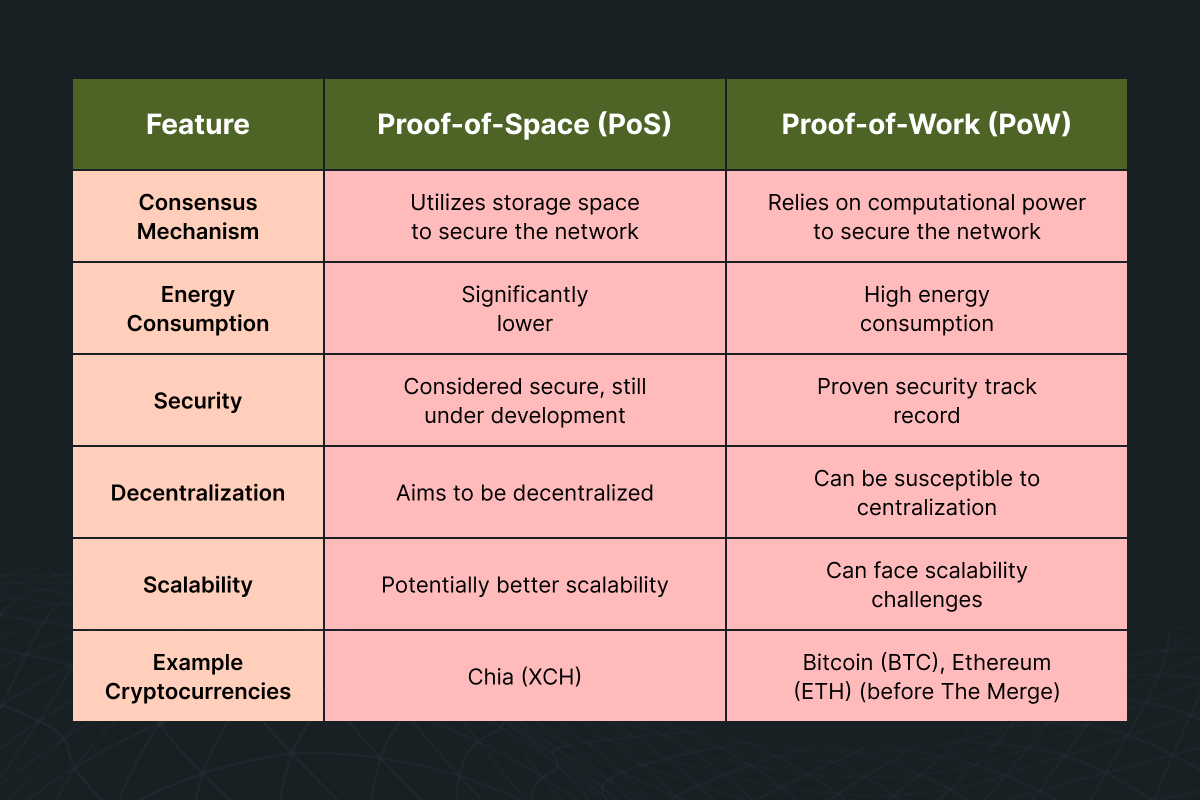
Chia Farming in Practice
With the fundamentals of PoS and PoT laid out, let's explore how you can participate in the Chia Network by becoming a farmer.
Basic Requirements
Hardware: Unlike PoW mining, which demands specialized and often expensive hardware, Chia farming is relatively accessible. The primary requirement is storage space. While any hard drive will work, solid-state drives (SSDs) offer faster plotting speeds, although their endurance can be a concern. Additionally, you'll need a computer with sufficient RAM to handle the plotting process. Luckily, most modern computers meet these basic requirements.
Software: Software-wise you’ll need the official Chia Network software, which is free to download and user-friendly. Once you can start with your Chia farming.
Farming Strategies
There are two main approaches to Chia farming: solo farming and pool farming.
Solo Farming: It means dedicating your own resources and keeping all the rewards (if you’re lucky enough to win a block), offering total control. However, the chances of a solo farmer winning a block are relatively low, especially with limited storage space. Moreover, it requires a substantial initial investment in storage disks and comes with maintenance responsibilities.
Pool Farming: This involves combining your resources with other farmers, increasing the collective chance of winning a block. Rewards are then shared proportionally based on each participant’s contribution (storage space). While individual rewards might be smaller, they are more consistent compared to the unpredictable nature of solo farming. However, pool farming requires trust in the pool operator.
The choice between these approaches depends on your budget, risk tolerance, and technical expertise.
Challenges and Considerations
While PoS offers significant environmental advantages over PoW and also offers lower barriers to entry, certain challenges remain. One concern is the potential for e-waste due to increased demand for storage devices. So, opting for energy-efficient drives and adopting responsible disposal practices are crucial. Additionally, frequent plotting can lead to wear and tear on solid-state drives (SSDs), and the long-term sustainability of this wear and tear is a topic of ongoing discussion. This calls for careful planning and exploring alternative methods like renting plotting services can mitigate this.
XCH Tokenomics and On-Chain Metrics
XCH (Chia) is a crucial aspect in understanding the economic structure and measurable activity of the Chia blockchain network. Here’s an insight into its tokenomics and key on-chain metrics.
The role of XCH
-
XCH plays a central role in the Chia Network ecosystem. It serves as:
-
A reward for farmers: Farmers who contribute storage space and participate in the PoS consensus mechanism are rewarded by XCH.
-
A unit of exchange: XCH can be used for transaction fees on the Chia Network.
-
A store of value: Like other cryptocurrencies, XCH can be held as a potential investment asset.
-
XCH Distribution Model
No Initial Coin Offering (ICO): Unlike some cryptocurrencies, the network did not raise funds through an ICO but instead sold preferred stock to secure funding.
Pre-mined XCH: 21 million are held in the strategic reserve. These tokens are intended for various purposes, including potential future buybacks and dividends when the company goes public, according to Chia's roadmap.
Farming Rewards: As the core incentive, farmers earn XCH for contributing storage space and securing the network.
Strategic reserve: This reserve, which includes the pre-mined tokens, is used for multiple purposes, including:
-
Lending: Increasing XCH liquidity through lending programs, potentially fostering wider adoption.
-
Reward distribution: Supplementing farming rewards if necessary to maintain network security and incentivize participation.
-
Investments: Granting XCH to developers and contributors, encouraging ecosystem growth and innovation.
Halving schedule: Similar to Bitcoin, XCH follows a halving schedule for block rewards, gradually reducing the amount of XCH generated over time:
-
2021-2024: 2 XCH per block
-
2025-2027: 1 XCH per block
-
2028 to 2030: 0.5 XCH per block.
-
2031 to 2033: 0.25 XCH per block.
-
After the start of 2034, 0.125 XCH is created in perpetuity.
On-Chain Metrics
To assess the health and activity of the Chia Network, we can analyze key on-chain metrics:
-
Total supply: The total number of XCH tokens ever created, including the pre-mined tokens, is 28,843,165 XCH.
-
Circulating supply: The number of XCH tokens currently in circulation, representing the available tokens in the market, is 7,843,932 XCH.
-
Block times: The average time it takes to generate a new block on the blockchain. Consistent block times are crucial for network stability and transaction processing efficiency.
-
Transaction fees: The fees associated with sending and receiving XCH on the network. These fees incentivize network participants and contribute to the network's security.
These metrics offer valuable insights into the Chia Network's activity, user adoption, and potential market dynamics. However, it's crucial to remember that on-chain metrics are simply a reflection of the network's current state. They shouldn't be solely relied upon for investment decisions and further due diligence is always recommended.
Source: https://coinmarketcap.com/currencies/chia-network/
The Chia Ecosystem & Notable Protocols
Chia Network’s innovative PoS architecture goes beyond just powering a single cryptocurrency. The unique design allows for the creation of various applications and protocols built on top of the Chia blockchain, creating a diverse and dynamic ecosystem.
Various Use Cases
Chia’s PoS system provides a secure and scalable foundation for various applications, including:
-
Decentralized Finance (DeFi): Users can participate in a broad range of financial activities like lending, borrowing, and trading directly on the Chia Network, creating a more accessible and transparent financial system.
-
Non-Fungible Tokens (NFTs): Facilitating the creation and management of unique digital assets like artwork, collectibles, and in-game items, offering creators and communities a secure platform for issuing and trading NFTs.
-
Oracles: Developers can create reliable bridges that connect the Chia blockchain to external data sources, allowing smart contracts to access real-world information and expand their functionality.
Chialisp – the Building Block of Innovation
These diverse applications are built using Chialisp, Chia's unique smart contract language. Chialisp offers several advantages, including:
-
Security: Prioritizing security to make it resistant to common vulnerabilities found in other smart contract languages.
-
Efficiency: Designed to be efficient, helping developers create complex applications without compromising performance on the Chia network.
-
Flexibility: Allowing for a wide range of functionalities, catering to various use cases, and supporting the development of innovative applications within the Chia ecosystem.
Notable Protocols
The Chia ecosystem is bustling with activity, and several notable protocols are already leveraging Chialisp to create innovative solutions:
Pawket: An open-source, secure wallet solution offering both online and offline functionality, optimized for both desktop and mobile devices. Pawket allows users to easily manage their XCH and CATs on the Chia blockchain.
Hashgreen DEX: A decentralized exchange built on Chia using state-of-the-art crypto exchange development technologies, facilitating peer-to-peer trading of digital assets without intermediaries, providing users with greater control over their assets and promoting transparency in crypto trading on the Chia blockchain.
SpacePool: A farming pool designed to normalize the frequency of farming rewards on the Chia network. While it doesn't increase the total potential profit, SpacePool helps farmers receive rewards more consistently. Committed to transparency, privacy, and support, SpacePool distributes 87.5% of the pool's farming rewards proportionally based on each participant's contribution.
MintGarden: An NFT marketplace dedicated to the Chia network. MintGarden allows creators and collectors to:
-
Create and mint single or bulk Chia NFTs directly to their wallets.
-
Explore and discover various Chia NFT collections.
-
Connect with other creators and collectors within the Chia NFT community.
-
Stay updated on the latest on-chain activities and developments within the Chia NFT landscape.
How the Future of PoS and Chia Leads to a Sustainable Path Forward
Beyond its immediate advantages, Proof-of-Space (PoS) has the potential to significantly impact the broader blockchain ecosystem. As more projects adopt PoS, the overall energy consumption of the crypto industry could decrease dramatically, paving the way for a more sustainable future.
Ongoing Innovations on the Chia Network
The Chia Network is actively exploring new avenues to enhance its PoS system and broaden its ecosystem. This includes:
-
Continued development of Chialisp: Ongoing improvements to Chialisp will allow for the creation of even more sophisticated applications and protocols on the Chia network.
-
Focus on developer adoption: Building a thriving developer community is crucial for the continued growth and innovation within the Chia ecosystem. Initiatives like hackathons and educational resources are encouraging developers to build on Chia's unique architecture.
-
Exploration of new use cases: The potential applications of PoS extend beyond traditional finance and digital collectibles. Chia is exploring the use of PoS in areas like identity management and supply chain tracking, showcasing the versatility of this eco-friendly consensus mechanism.
While Chia is leading the PoS innovation, it's important to acknowledge other projects contributing to the advancement of this sustainable approach. Projects like Cardano, Solana, and Polkadot are also exploring unique PoS implementations, furthering the collective effort toward a more energy-efficient crypto environment.
A Sustainable Future for Cryptocurrencies?
The rise of PoS and the continuous advancements within the Chia Network, alongside other sustainable blockchain projects, offer a glimpse of a future where cryptocurrencies can thrive without compromising environmental responsibility. As research and development continue, consensus mechanisms like Proof-of-Stake and Proof-o-Space have the potential to revolutionize the way we interact with and utilize this transformative technology. However, continued innovation, collaboration, and responsible implementation are crucial to ensure a truly sustainable future for the entire crypto ecosystem.
Post Author

Explore Deep's insightful blog posts that help businesses stay ahead of the curve, explore new possibilities, and unlock the full potential of blockchain technology
Build your dApp on blockchain networks utilizing eco-friendlier consensus mechanisms.
Build your dApp on blockchain networks utilizing eco-friendlier consensus mechanisms. If you're looking to develop a dApp that is innovative as well as sustainable, at Codezeros, we can help. Our team of developers are experts in blockchain development utilizing greener consensus mechanisms like Proof-of-Stake or Proof-of-Space.

